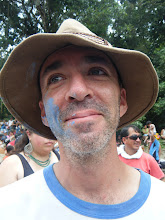| Salar Uyuni |
Day 1
If you remember we started our tour in San Pedro de Atacama, Chile. It is also possible (and maybe better and cheaper) to start a tour to the salt flats in Uyuni or Tupiza, Bolivia. Our tour starts with a bus trip to the Chilean passport control and then a half hour drive to a mud brick shack in the desert that serves as the Bolivian passport control. Here we are given hot drinks and sandwiches while we wait for our jeep to arrive.
| A cheeky fox begging for some breakfast. -These small canines should not be taken lightly our driver tells us that one can take down a full-grown llama photo courtesy of Hiro and Rena |
| Taking turns squeezing into the back of the jeep |
Back in the jeep for a short drive and we get to the Laguna Verde (Green Lake). The green is caused by copper in the water. We are told that we are unlucky today because there is no wind. Wind blows causing the water to stir the minerals and create a shiny, bright green color. Today we only see one small spot of this effect.
| Unfortunately, not a green lake today |
| That tiny spot in the bottom left third of the photo is Mika trying to get a better view of Dali's rocks |
After everyone dries off it is back in the jeep to stop at what appears to be inside the crater of an active volcano. Everywhere are natural small and large cauldrons of bubbling volcanic clay and steaming gas spewing from the ground. There is a slight smell of sulphur in the air. Walking around carefully not to step on any soft spots lest my shoes coated in hot volcanic mud I wish that I had a bottle to collect the mud which I am sure makes a great souvenir mud mask. This just might be my favorite place on the tour.
Check out this "hot" video!
The last stop for the day is at our hotel. Lunch is very late, not very good and the drivers do not want to bring us anywhere else so we are stuck for the rest of the day. We were correctly warned that it will be very cold here at night. After dinner with the temperature approaching freezing we go out to look at stars and I see the Southern Cross for the first time. To sleep Mika and I decide to maximize warmth and share one small single bed. This ends up being a mistake because our six wool blankets actually make me too hot. Six wool blankets are also very heavy. It feels like a llama is laying on top of me all night. Plus me and many others wake up all through the night with headaches. This will happen when you try sleeping at around 4500 m (14.764 ft).
 |
| Group dinner photo courtesy of Hiro and Rena |
| A flamingo retirement community |
| "Ugh! I should have stayed in Florida" |
| Tree Rock and Tourists I never quite figure out why, but jumping photos seems to be the thing to do |
| Good someone put this sign here to make sure we are not peeing behind the wrong rock |
| A vizcacha waiting for a treat |
| More lake and mountains |
| A smoking volcano |
 |
| Salt block walls, table and stools |
So far all of the stuff that we have been seeing for the past two days is nice, but really it is just to keep us busy. Today, our visit to Salar Uyuni - the salt flats is really why we are here and why we made such an effort to get to Bolivia. We leave the hotel after breakfast and take a short drive to the entrance of the salar.
 |
| First view of the salt flats covered in water |
We continue on and the salty ground slowly goes from being covered in four inches (10cm) of water to being wet to finally completely dry. And this is where our tour ends because of the accident. So, instead of seeing some other sites, such as where they process the salt, we head straight to town driving for about an hour through the vast salt land that is Salar Uyuni.
To read about the Uyuni accident and its aftermath click here.
I did manage to squeeze in a few more photos. Salar Uyuni really is stunning and I have run out of superlatives to describe it, so I will just finish off with my last few photos of the tour.
 |
| All the ground is edible salt which we are now using for cooking |
The International Rambler Interesting Tidbit:
Salar Uyuni holds 50% of the world's lithium deposits. Bolivia, Argentina and Chile have 85% of the world's supply. Insteaqd of just exporting the raw material Bolivia has recently broken ground on a factory that will so soon be manufacturing. So digital camera batteries Made in Bolivia might soon be at an electronics store near you.


















No comments:
Post a Comment